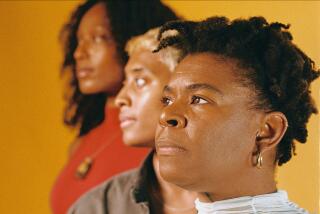Revry wants to be the streaming service for and by LGBTQ people
- Share via
When filmmaker B. Danielle Watkins pitched her series about two lesbian roommates living in Las Vegas to a large streaming entertainment company, the executives were, at first, complimentary.
But then they brought up their concerns. Watkins’ show “3030” features only LGBTQ characters, and the executives worried their audience would feel alienated. They asked her to re-shoot the series and add straight characters. That would make it more “relatable,” she said they told her in early 2017.
Hard pass.
Instead, Watkins took her series to Revry, a Glendale-based streaming service that bills itself as “unapologetically queer.”
“Revry has done what nobody else has done,” Watkins, 34, said. “They’ve given us a voice without a screen over it. They allowed me to maintain creative control. They haven’t taken our voices from us.”
Revry bills itself as the first global LGBTQ streaming service and has grown rapidly since its founding in 2015, hosting more than 4,000 hours of films, shows, podcasts and music.
For decades, Hollywood has failed to consistently depict a diverse range of LGBTQ people in films and movies. Revry is seeking to fill the void by distributing content focused on underrepresented populations.
“They’re hungry for stories that more reflect what’s going on with them right now, as opposed to the more mainstream [studios],” said Christopher Rodriguez, Revry’s chief business officer.
Similar to Hulu’s old-tier system, Revry offers its content — more than 300 films and 100 shows — either free with advertisements or without ads through a paid subscription service of $6.99 a month, or $59.99 a year.
Over the past three years, Revry says it has broadened its reach to more than 50 million potential viewers by offering its content on more traditional platforms such as Apple TV, Roku and Amazon Fire, and third-party channels including Pluto TV. By the end of 2019, the company anticipates reaching nearly 200 million viewers in four continents.
Revry got a major boost in February when Comcast Corp. announced it would soon add Revry as an option to its Xfinity X1 service.
“X1 uniquely curates hundreds of movies and shows by identity and community because we are committed to amplifying stories that represent the intersectionality and expressiveness of diverse human experience,” said Jean-Claire Fitschen, executive director of multicultural consumer services for Comcast cable, in a statement. “We see that same commitment in Revry through their distinct original programming and all-embracing entertainment.”
The idea to start Revry came in late 2015 after the company’s chief executive, Damian Pelliccione, bought an Apple TV and realized, as he searched through the app store, that there wasn’t an LGBTQ-specific streaming app.
Pelliccione, who had worked in new media at Make.TV and eTribez, brought together Revry’s three other co-founders — Rodriguez, along with Alia J. Daniels, chief operating officer, and LaShawn McGhee, chief product officer. The entrepreneurs launched the first version of the app in March 2016, funding it through sweat equity and small investments from family and friends.
When Revry began, its executives wanted to license shows and films that would help them fully represent the LGBTQ community. But Revry’s team soon realized they couldn’t achieve that goal by simply licensing preexisting content. Although there were plenty of “gay” films available, they tended to be only about gay white males, and the plots were usually focused almost entirely on sex or AIDS, or had relegated LGBTQ characters to token roles.
It’s fair to say the quantity of the LGBTQ representation on TV and in film has improved, but the quality still has a long way to go.
— Rich Ferraro, a spokesman for GLAAD
Revry’s executives wanted to highlight the facets of the community that are often overlooked: trans voices, more uplifting lesbian story lines, gender non-binary characters and people of color. Watkins’ “3030” fit that bill. When Revry premiered the first episode of the second season of “3030” at its Out Web Fest last year, it was to an enthusiastic sold-out crowd.
Although major studios have started to acknowledge the existence of LGBTQ people in their shows and films, the market remains underrepresented.
In 2017, only 14 of 109 films released from major studios included a character identified as LGBTQ, down 6% from the previous year’s total, according to media watchdog GLAAD, which tracks LGBTQ representation in TV and film. Gay men remained the most represented group in film, and there were no trans-inclusive films from major studios in 2017.
Additionally, streaming services continue to create or license shows with non-transgender actors portraying trans characters, an outdated and damaging practice, GLAAD said.
“It’s fair to say the quantity of the LGBTQ representation on TV and in film has improved, but the quality still has a long way to go,” said Rich Ferraro, a spokesman for GLAAD. “And by quality, I mean the diversity of stories, and that includes LGBTQ people of color … and stories of LGBTQ people where the fact they are LGBTQ is not the focus of the story.”
It remains to be seen whether Revry can transition from a startup to a sustainable business.
Revry’s business model relies on buying and distributing content targeting the LGBTQ community, making money off advertising, subscriptions, distribution and licensing.
The company’s annual revenue tripled last year to more than $328,000, company executives said.
Since inception, Revry has incurred losses of almost $435,000 and relies on third-party financing to fund its operations, according to an independent accountant’s report.
To raise more capital, Revry recently held a crowdfunding campaign on SeedInvest, which is kind of like a Kickstarter campaign for start-ups. The company raised $319,840 to finance its growth.
“This year, we are going to hit an inflection moment, and we will be cash-flow positive, and that’s something that’s really exciting,” Pelliccione said.
It’s not uncommon for a startup to lose money as it establishes itself, said Eugene Lee, CEO of ChannelMeter, a San Francisco social video analytics firm.
Revry isn’t rapidly burning through money, spending about $100,000 a month, Lee said, after reviewing available financial information.
Still, Lee said the business faces several challenges. It remains unclear what percentage of the LGBTQ population — an estimated 11.3 million adults in the U.S. — would subscribe to Revry. Another question is whether the platform will be able to broaden its audience enough to attract people outside of the LGBTQ community.
Then there is the competition. Heavy hitters like Netflix and Hulu have far more capital to spend on content. At the same time, Revry could attract creators from YouTube and other online platforms, content that would bring in more young people interested in subscribing.
It’s a chicken and egg problem — you can go acquire a customer, but if you don’t have enough content, they’re just going to leave.
— Eugene Lee, CEO of ChannelMeter
“The entire purpose of having this machine is going and acquiring more customers,” Lee said. “It’s a chicken and egg problem — you can go acquire a customer, but if you don’t have enough content, they’re just going to leave.”
Pelliccione frequently makes the point that, unlike Netflix and Hulu, Revry is an identity-driven brand. No one wears a Netflix T-shirt.
“I use the example of being a consumer of a company like the Honest Company or Tesla or Whole Foods — it says something about your identity when you’re a consumer of those products, and Revry has positioned itself in that same cause and mission-driven product space, “ Pelliccione said.
Revry offers viewers a range of LGBTQ stories told in its films and shows.
Half of Revry’s viewers are in the U.S., the other half from more than 100 countries, with the heaviest international traffic coming from India, Brazil and China.
The majority of their shows are shorter, similar to webisodes, but those shorter shows can run as long as 20 minutes per episode.
The original series “America in Transition” features intimate portrayals of trans stories. “Septo” is an original series that tells a lesbian love story set in Brazil. And “Queens of Kings,” an original series, focuses on drag performers in Brooklyn.
Evan Zampella, one of the “Queens of Kings” creators, said the first season of the show debuted on a different millennial-focused entertainment platform. But he said it felt like they were hosting “Queens of Kings” to check a box.
Once the show launched, the company [which he declined to name] hardly promoted it. Revry has taken the opposite approach, he said, promoting the show so much that, when Zampella has made business trips to other countries, people mention to him that they’ve seen “Queens of Kings.”
“For every ‘Will and Grace’ that’s out there, Revry is going to have 10 or 15 programs that go into every niche of the LGBTQ community, and they’re going to be focused on real stories,” Zampella said. “By having a platform just focused on that, it allows for every member of the community to be accepted and have a story that relates to them.”
More to Read
Inside the business of entertainment
The Wide Shot brings you news, analysis and insights on everything from streaming wars to production — and what it all means for the future.
You may occasionally receive promotional content from the Los Angeles Times.











